Higher ed is getting social. With such a large audience, from students, prospective students and faculty to alumni and sports fans, the potential for social media in higher education is huge.
Benefits of social media in higher education
Student recruitment
It’s a well-known fact that younger generations use their phones more than older ones. This is where they conduct research on products, services and organizations. Universities can (and should) take advantage of this for recruiting. If universities want to attract students, then they need to have an engaging brand presence online.
Related: How to take charge of your university’s branding
Build your brand
Social media can be a powerful tool for building brand awareness. From highlighting new research to showcasing student projects and achievements, higher ed social teams can play a powerful role in attracting potential students, faculty and donors to the university.
Boost student engagement
Engaged students are more likely to stay enrolled and graduate. They are also more likely to become brand advocates encouraging their friends, family and children to participate with your university in the future. Taking a fun or lighthearted approach with content on Instagram or Tik Tok will resonate with students in a way that official announcements won’t.
Higher ed social media strategies
Establish your brand
Whether your higher ed team has been using social media for a while or is completely new to it, you should make sure that your brand is well-represented on your social media accounts. You never want potential students to come across your profile and wonder if it’s the university’s actual account. It should be obvious. Some things that will help establish your brand on social media are:
- Username/handle: Keep usernames the same across all platforms. This way, students can easily find you on Twitter, Facebook, Instagram and any other platforms you’re on. If you’re concerned about being able to register the same username across all platforms (and don’t want your handle to end up like @Lucid_press0018), here’s a tip. You can create accounts on new social media platforms, even if you don’t want to use them yet. Later on, if you find that your audience is using that platform, you’ll already have the username.
- Images: Just as usernames should be the same across platforms, your profile pictures should be easily identifiable. Along with your profile picture, using similar colors (such as school colors) in your images will further affirm your identity. A tip regarding the images you post: choose one or two photo filters that fit your brand, then only use those filters on any images you post. This creates a uniform look for your content that will be recognizable to your audience.
A great example for establishing your brand on social media is Coca-Cola. All of the Coke accounts feel familiar. Each picture uses a similar filter that’s cohesive with their branding, and you can see red in all of their images.
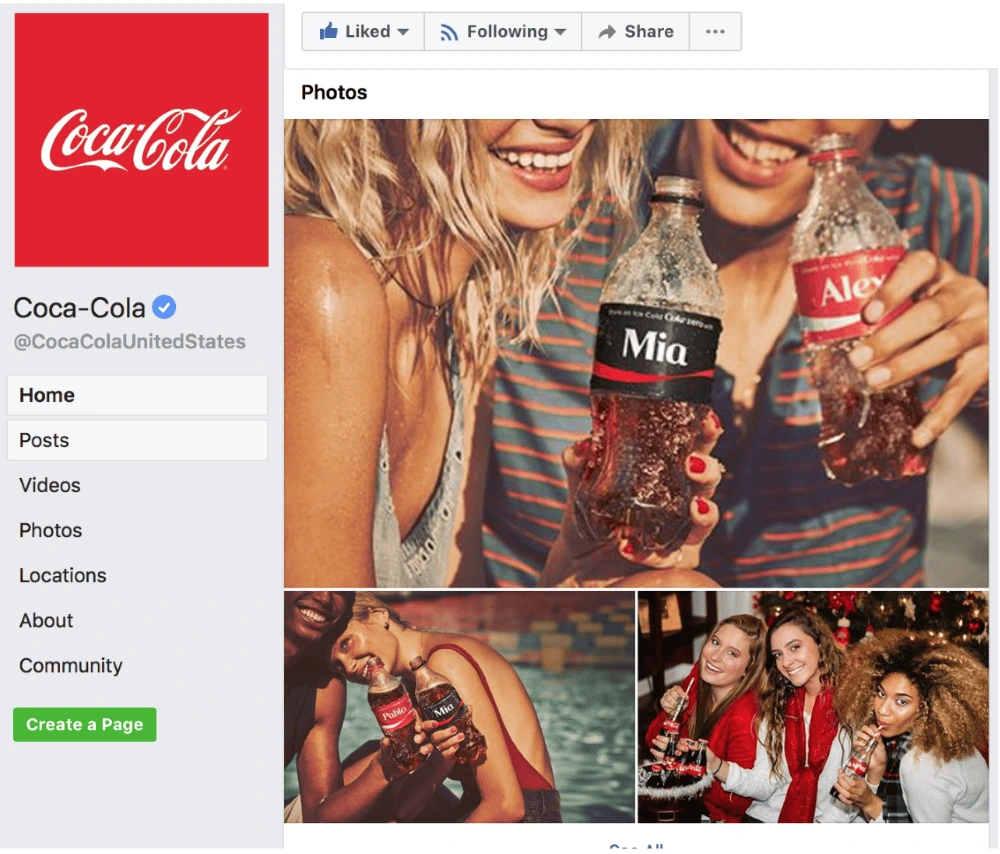
- Bio: Most social media platforms offer a place to include a bio for your university. Don’t waste this space. Bios are an excellent opportunity to show students what’s important to the school. You can even include a link to a page where interested students can learn more about the university (for example, by signing up for a newsletter).

- Tone & voice: Before you start posting, decide what your brand voice will sound like online. Will you be dry and professional? Will you use slang? The same goes for finding the right tone to use in your posts. Will you be happy, neutral, silly, snarky or witty? These decisions will shape your brand as people come to associate that voice with your university.
Speak to your audience
When it comes to social media, go where your audience is. Post content that’s designed for the platform and meaningful to them.
- Use the right networks: Are prospective students using Instagram, Snapchat or Facebook? Find out where your audience is, and start building a presence and community there. Some platforms might seem difficult to use as a university, like Snapchat. This is where you get to be creative and connect with students in innovative ways that no other universities are using.
- Create content specifically for your audience: What do potential students want to know? Share successes your school has experienced, student activities on campus, tips for prepping for college, what to bring to a new dorm room, what research is happening at your university, etc. Find out what your students are curious about, and create content that’ll be interesting and useful to them.
Harvard University’s social media often posts student-related stories that are relatable to other students. By focusing on the students, it shows that they come first at Harvard. Here’s an example of a personal story that was shared on the Harvard Facebook page:
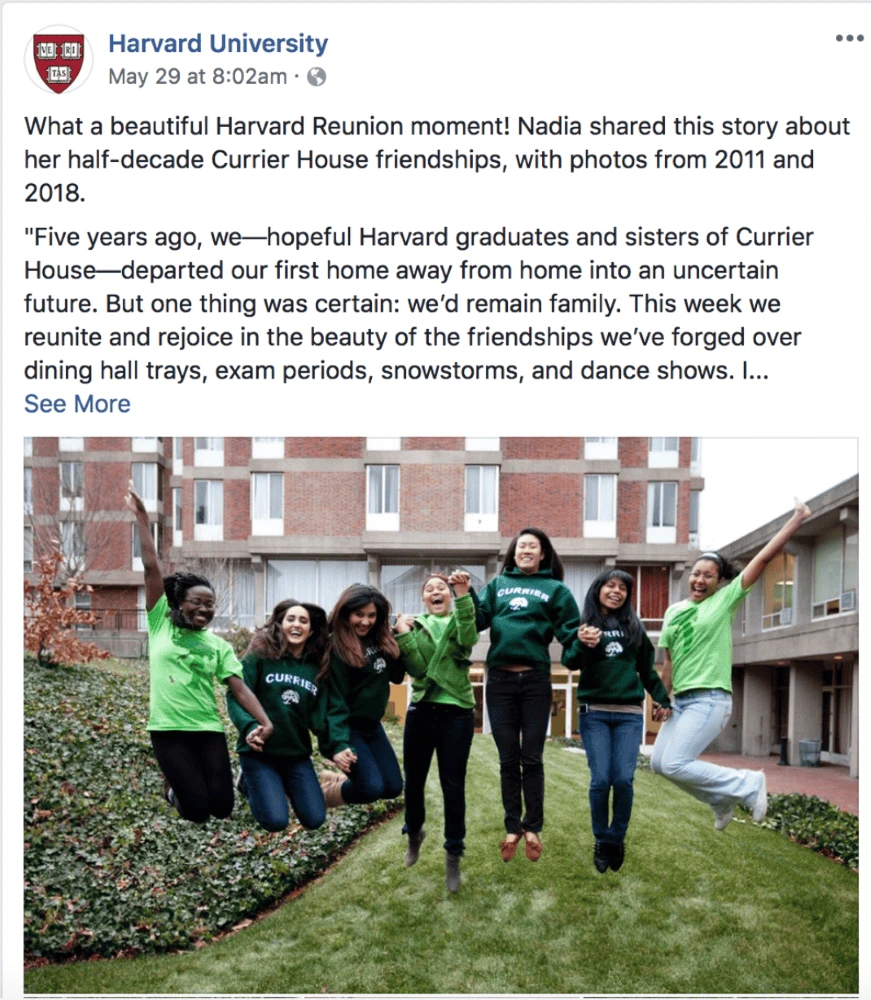
Key takeaways
Social media is no longer a “nice touch” for your higher ed marketing plans; it’s essential to establishing your brand online. Build your profiles with consistent usernames and imagery. Create a guide for staff members that includes the colors, photo filters, logos, tone and voice to use in university-branded social media to maintain consistency.
Finally, make sure that you’re on the right platforms, sharing content that’s engaging for your audience. Use the same voice in comments, personal messages and public posts. Be where your future students are, and give them a reason to notice your university.
One major challenge many four-year colleges and universities face today is student retention. A substantial number of students are starting college only to drop out at some point. When students don’t make it to graduation, it’s costly for both the students themselves and the universities they leave behind.
Related: Higher education marketing—crucial strategies & trends
Data from the NSC Research Center found on average 61.6% of entering freshman in 2016 returned to school the following fall semester. 73.9% of freshman returned to the same university or transferred to continue their studies. Retention rates among white and Asian students tend to be higher while black and hispanic students fall below average. Among black students, only 52.5% continued school at the university they originally enrolled in.
But before you create a plan to address student retention, it’s important to first understand what’s causing students to drop out.
- Cost. The costs of higher education have been rising continually, and if students can’t receive financial aid, then staying enrolled at college can be difficult for many to afford.
- Homesickness. When students begin their college careers, many don’t know anyone else at the university. If students have difficulty making connections with peers around them, homesickness and loneliness can cause students to drop out.
- Unclear expectations. Adjusting from high school to university can be difficult for many first-year students with certain expectations regarding academic success as they discover different expectations in college.
While these three challenges merely scratch the surface of student retention concerns at universities, there are solutions that can help any college create a student retention plan. These five steps will help you to create a retention plan that will fit the unique needs of students at your university.
Know your students
To help your student body overcome the obstacles they encounter during their educational journey, you first have to know your student body. What are the biggest issues facing the students at your university? Finances, mental health, isolation, lack of resources? It’s hard to find a solution if you don’t first find the root of the problem.
To figure out what your students need, collect data on which programs and resources on campus are already being used. Poll your student body to find out what challenges they’re facing. Create an open dialogue with your faculty so they can address the problems they see affecting their students. By gathering this information, you can brainstorm and try new approaches to helping your students succeed.
Define student success
Based on your research, define what student success looks like at your university. This could include the rate of students making it to graduation, the time it takes students to graduate, improved learning outcomes, experiential learning, or more employed students at graduation. This definition will vary for each school, depending on the different programs available.
Once you’ve crafted this definition, share it with your faculty, staff and student body. This gives the entire campus a common goal to work toward. When students understand what success looks like within your institution, they’ll be more prepared to do the things they need to reach success. Many students enter college unsure of what it means to be a successful college student, and creating this clear goal for them can help them better adapt to college.
Empower your students with resources
Many college students move away from home to attend school and may feel isolated in a new, possibly foreign environment. They’ll be learning to live on their own while also handling research projects and trying to pass their finals. When faced with these overwhelming difficulties, it might seem easier to the student to drop out. By providing resources to your student body, you give them the power to overcome these challenges.
Some resources that can be invaluable to students include:
- Financial services
- Writing center
- Tutoring center
- Counseling
- Workshops for test-taking skills
- Outreach and engagement centers
- Student unions and clubs
- LGBTQ+ support organizations
The options for resources are limitless, and by understanding your student body, you can create organizations that help your students feel empowered.
Set up an intervention network
The earlier students get help when they’re facing problems, the better their chances are for overcoming challenges and finding success at school. This is a process that takes everyone contributing to be effective. This means that professors might need to receive training on how to recognize students who are beginning to struggle.
As a university, you need to establish warning signs for professors to watch for in their students. Professors can then refer these students to counselors or advisors who can reach out with resources and information that can help them.
It’s encouraging for students to know there are people at the university who care about them and who notice when they’re missing class or struggling to keep up.
Create a community
Many first-year students come to college knowing very few people there, if any at all. It’s vital to help those students make connections and friendships that make them feel like they belong at the university. Helping students find their community can keep homesickness at bay.
Creating learning communities and clubs while providing volunteer opportunities in the community can help students make valuable connections with others. Getting involved on and off campus also gives students the opportunity to gain experience for their future career.
“It’s important for students to figure out what they don’t want to do, so they can figure out what they want to do. College is a great time to experiment by volunteering with local organizations and highlighting some potential career paths. Students have so many different pathways that they can take as they begin their own lives and make their own choices.”
Dustin Ramsdell, Helping College Students Build Community Connections
Key takeaways
First-year students and transfer students from community colleges often feel overwhelmed by the challenges of starting their academic career at a new university. Universities can help smooth that transition and increase the success rates of their students by implementing a student retention plan.
These retention plans should encompass ideas for the following five areas:
- Know your students
- Define student success
- Empower your students with resources
- Set up an intervention network
- Create student communities
By focusing on these five areas as you create a student retention plan, you can increase your students’ success rates and create happy, successful alumni.
Is your school delivering a strong, consistent message with its brand marketing? Learn more in our free ebook: Branding in student recruitment
Open source learning. A global economy. Shifting demographics. These are just a few realities impacting your college recruitment strategy.
According to the National Student Clearing House Research Center, Spring 2018 college enrollment across U.S. campuses was down from the previous year. University and college recruiters have shifted to overdrive in response.
Related: How to improve higher ed student retention
Some focus on radio ads, alumni referrals and online recruiting fairs. Others build interest on social media and at live events.
Regardless of the outreach method, one thing is clear: In today’s higher education landscape, recruiters must be increasingly creative and strategic to attract new students.
A varied college recruitment strategy
“The times, they are a-changin’,” sang Bob Dylan. Want to keep up? Pay attention to your audience.
Today’s students don’t want a cookie-cutter version of their parent’s university experience. They’re also not impressed by (pun alert) old-school marketing tactics.
Instead, create a varied strategy that will reach your top prospects on multiple channels. Essentially, you want to provide engaging information that helps your college sell itself.
Use multi-channel enrollment marketing
Most colleges and universities know their target demographic well, and they market to basically the same audience year after year.
However, success also depends on reaching new targets via a multi-channel approach:
- Website — a branded, responsive hub that’s easy to navigate and engaging to use
- Blog or vlog — where interested prospects go for bite-size information
- Social media — critical online outreach, both locally and internationally
- Email campaigns — important tactic for lead generation and nurture
- Direct mail — still relevant and effective marketing for certain audiences
- Phone calls — an effective, if time-intensive, method for personal outreach
- Brand ambassadors — relatable outreach by faculty, students & alumni
- Parent outreach — critical influencers of your target audience
- Campus visit days — highly successful recruiting events, up close and personal
- High school visits — successful outreach that meets students where they are
- College fairs — key events that can market your institution both off and online
- International markets — a growing segment of your target audience
Now, for a few of the most helpful enrollment marketing strategies…
Recruiting college students online
It’s no surprise that most prospective students live online, particularly on mobile technology.
So, today’s recruiting strategies must be mobile-friendly. End of story.
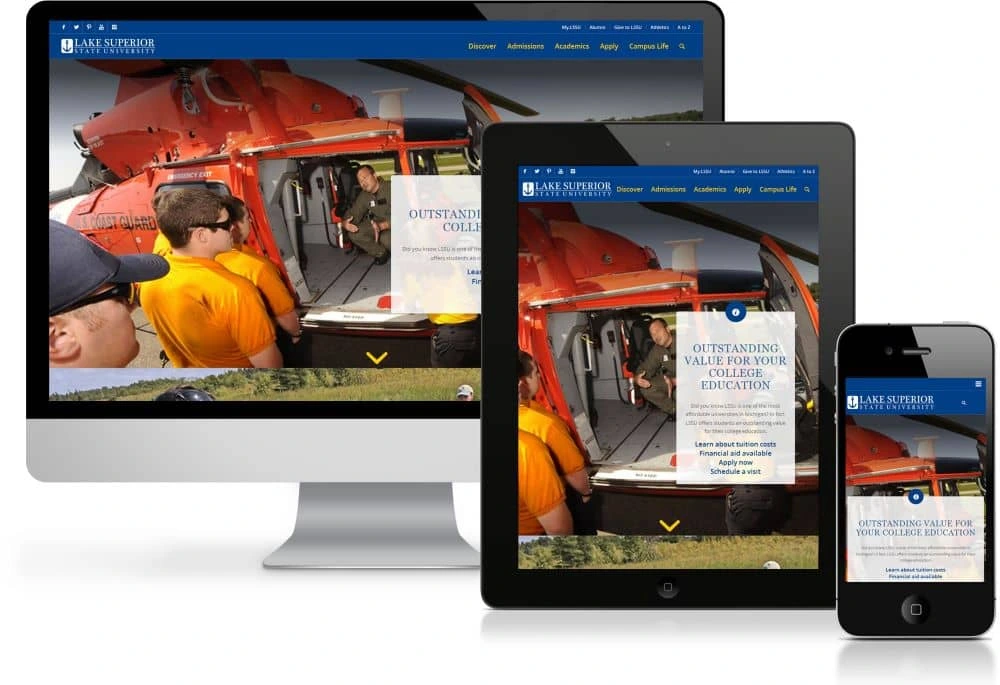
Source: Lake Superior State University
Responsive web design is no longer optional. But, you’ll stand out even more by offering mobile-friendly instruction and interactive pages.
For instance, students are wondering what they’ll learn on your campus. Why not show them instead of tell them?
Continuing education is common enough. But, standout institutions are experimenting with AR, game-based platforms and social learning models. Just one interactive feature on your site can put you ahead of the curve.
Even without all the technological bells and whistles, you can still provide value to new recruits.
Offer valuable resources
Don’t just throw a bunch of content on your website and call it good. Instead, create a user-friendly path that puts visitors at ease.
Which resources are clicked on the most? These might include:
- A catchy, above-the-fold video
- A listing of popular majors
- Programs and career opportunities
- Student and alumni testimonials
- Admissions deadlines
- Financial aid information
- Data-rich infographics
Simplify the application process
Of course, what you don’t include on your homepage can be equally important.
Generally, anything that simplifies your navigation and motivates would-be students to apply online is a good thing. Often, it means including more white space in your webpage design.
Face it—applying for college can be a daunting task even for the initiated. So, a user-friendly interface is essential.
Why not include a pithy video tutorial or a colorful step-by-step checklist to make the application process less painful?
Also, non-traditional students (e.g. adult learners, international students) generally want to know about credit transfers, flexible course listings, and financial aid options.
Build your blog
Most colleges today have a blog. What about your college?
More importantly, does your blog cover the topics your prospects care about most?
Boston University’s blog regularly shares pithy thoughts and videos by faculty members.
Likewise, Cornell University publishes “life on the hill” posts that help wannabes sample current students’ daily academic routines.
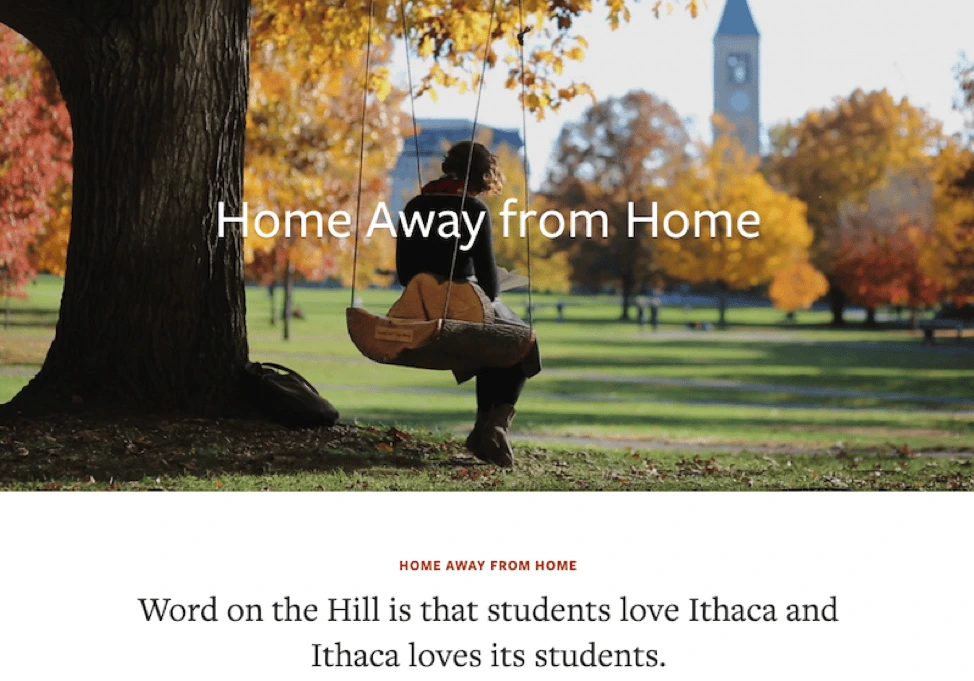
Source: Cornell
Your blog might also feature guest posts by alumni, video tours, listings of popular courses, and user-generated content.
And of course, the most popular blog posts should factor into your upcoming email campaigns.
Direct interaction with prospective students
As you can see, a successful recruiting strategy contains many moving parts. But, personal interactions (phone calls, campus visiting days, etc.) are still the most powerful of these.
According to Hanover Research:
“Despite increased digital activity, a recent survey found that the most effective marketing strategies for universities are nevertheless events‐based and involve direct interaction with potential students.”
After all, sometimes it really is about your newly upgraded facilities, swanky campus and student perks.
Most prospects who’ve gotten this far already know about your tuition costs, financial aid options, and faculty-to-student ratio. A successful campus visit just helps close the deal.
International student recruitment
Quick—what’s the Chinese version of Twitter?
If you’re recruiting students from China, you already know the answer to this question. (It’s Weibo, by the way.)
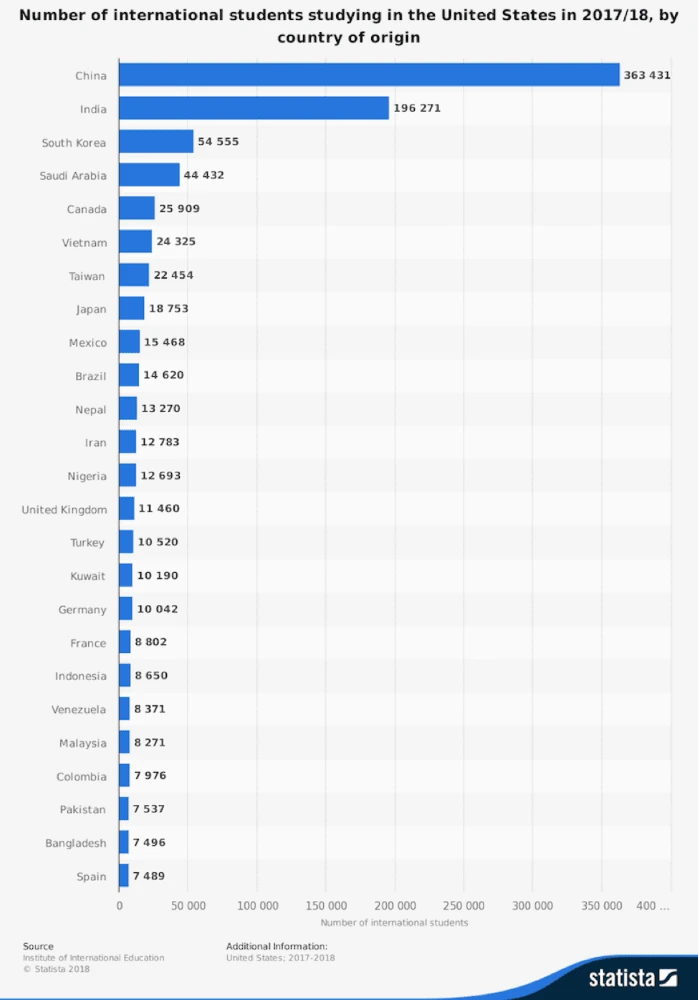
Source: Statista
As you can see, international student recruitment is alive and well at American colleges and universities.
As discussed earlier, your website needs to be user friendly and easy to navigate. This is particularly important if you’re appealing to international students.
Your site should help this target demographic understand the advantages of studying in America—and at your institution specifically.
Simple videos and infographics can also help smooth potential cultural barriers.
Do you already feature international students in your recruiting videos? If not, now’s the time to help them share their story—in their language.
As appropriate, include video links in your email campaigns. Share these on international social media channels.
Your website should also include pages dedicated to the specific needs of international students and recruits.

Source: Cornell
Reduce educational jargon
Higher education is adrift in educational jargon, which can be painful even to American-born students.
All those acronyms can be excruciating to international applicants. Whenever possible, cut them out and use a simpler description.
In the end, remember: Every positive interaction with a brand depends on clear communication.
Key takeaways
Now that you’re familiar with what it takes to build a successful recruiting strategy, let’s wrap things up by considering the real-life example of Western Colorado University. WCU’s creative team struggled to manage their recruiting strategy and materials, as they were too busy trying to keep their head above water.
Read Western Colorado University’s full case study here to learn how they dealt with their recruiting and marketing problem.
Is your school delivering a strong, consistent message with its brand marketing? Learn more in our free ebook: Branding in student recruitment
According to the results of a survey conducted by the Chronicle of Higher Education, 55% of private colleges and 44% of public colleges didn’t meet their enrollment goals in 2017. Was your college one of them?
With the looming threat of student debt and a decreasing belief in the importance of going to college, marketing is becoming a crucial factor for institutions who want to boost their numbers.
Related: How to take charge of your university’s branding
And it’s not just about attracting prospective students, either. Engaging your current students is essential if you want to build a strong brand with a positive reputation.
In this post, we’ll tackle the key tactics you need to employ as part of your overall marketing strategy. We’ll also look at some of the hottest trends in higher education marketing today.
Higher education marketing strategies
When it comes to strategies for education marketing, things move quickly.
With a young, digitally minded demographic and the continual emergence of new tech and trends, education marketers must work hard to stay ahead of the curve.
These four tactics will help you tighten up your marketing plan and push it forward.
1. Think mobile-first
Today’s college students live with a mobile-first mindset, using their smartphones as the primary device for carrying out a range of activities.
A recent study from the Interactive Advertising Bureau (IAB) titled Generation Z & Young Millennials: Mobile First on Campus found that 55% of students have acted after seeing a relevant ad on their mobile phone.
For education institutions, this means mobile-first advertising should be a focus in their enrollment marketing plan.
Keys to success for mobile-first higher education marketing:
- Keep the creative work simple and design primarily for the small screen.
- Choose the apps that students use most on mobile—such as Snapchat, YouTube, Instagram & Spotify.
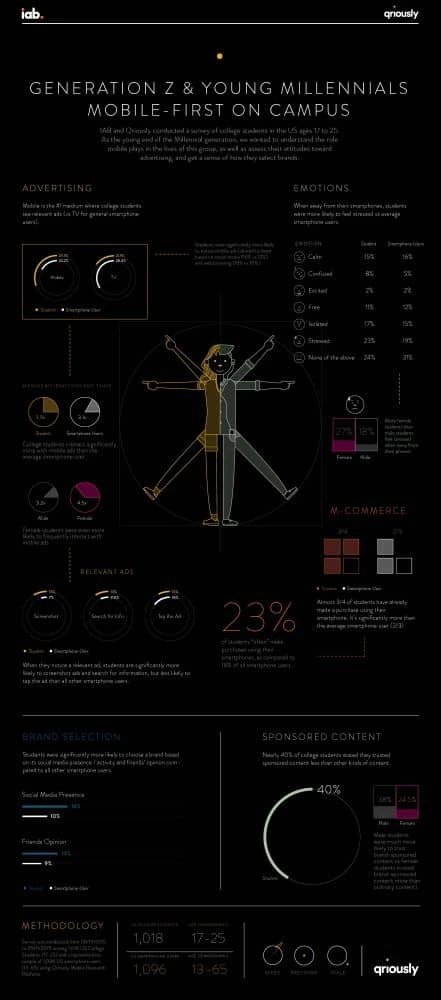
Source: IAB
2. Choose the right social media platforms
That first point nicely brings us to thinking about platform choice in general.
As much as it’s crucial to pick the right channels for digital marketing, it’s also important to think strategically about every platform you’re putting energy into.
A 2019 article from Business Insider reported that Gen Zers between 13-21 used Instagram, YouTube and Snapchat more than any other social media platforms.
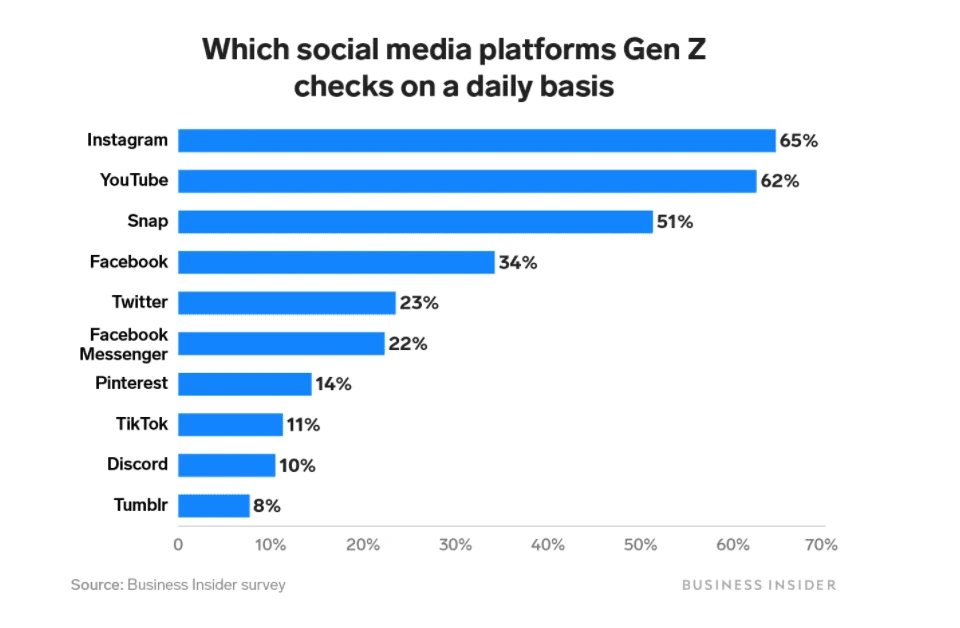
How to leverage the right platforms for successful higher education marketing:
- Pay attention to the numbers and direct most of your energy where young people spend their time online.
- Be creative with your approach, and look for smart ways to integrate new tech (more on this in the “key trends” section below).
- Wondering what to post about? Student and faculty spotlights, alumni updates, photos of campus and event announcements are a great place to start. Creating hashtags for your school, departments and clubs can help increase engagement as well.
3. Build a consistent university brand
Your brand is more than just a logo and a set of colors. It’s the impression you generate from every interaction you have.
As Jeff Bezos, the CEO of Amazon put it: “Your brand is what people say about you when you’re not in the room.”

Source: Lucidpress
Brand consistency, then, means maintaining control over the way you’re viewed. It should be a central focus in today’s digital landscape, where the number of channels and touchpoints is continually growing.
If you want a recognizable and trustworthy brand, uniformity is essential.
Tips for building a consistent higher education brand:
- Think beyond the visual aspects and consider messaging and tone of voice, too. How does your content make people feel? How would you describe your brand’s personality?
- Take advantage of a brand templating platform like Lucidpress. Users can easily access and edit branded templates all in one place, and your marketing team will have much more control to lock down brand elements before access is shared.
4. Answer key questions
Using the institution’s website, blogs and emails to answer key questions from prospective students is a tactic that should feature prominently in every enrollment marketing plan.
Research from mStoner found that, contrary to what education professionals believe, most teen college prospects (64%) prefer to consume college website content through text and articles.
Rather than answering the most obvious questions, think outside the box and dive deeper into exploring what’s on your prospects’ minds.
What are they typing into Google? What are they asking their friends? What information are they looking for when they visit your site?
Targeting long-tail keywords in the form of specific, beyond-the-obvious questions will help you increase your search rankings. For example, rather than “student accommodation Chicago,” target search phrases like “what’s it like to live in Chicago as a student” or “where is the best area for students in Chicago.”
How to effectively answer key questions in writing:
- Know the audience you’re speaking to and direct the content to them. Use the type of language they’d use, and make sure any references or explanations are relevant and appropriate.
- Keep it brief and concise, and make sure it’s easy to read and scan through by using clear formatting such as subheadings, bullet points and numbering.
5. Centralize your marketing
With departments spread out all over campus, it can be hard to know what marketing tactics everyone’s using and what’s been effective or not. A centralized marketing department will let you track spending, various campaigns and their results.
With a centralized approach, you’ll be able to align KPIs, standardize your marketing and in turn, standardize your brand. Scheduling regular syncs with each department will help all stakeholders stay in the loop with your school’s central marketing goals.
6. Optimize email campaigns
Marketing automation tools can help you optimize email and reach more prospective students. Email automation platforms will let you personalize messages and send emails at the right time, when they’re most likely to be read. Plus these tools will make sure your emails aren’t routed to the spam folder.
You can also do A/B testing to see which messages your audience responds to better. With A/B testing you can narrow your focus and continue to sharpen your brand’s voice and messaging to appeal to different student groups.
Key higher education marketing trends
Now that we’ve talked effective strategies and overall approach, let’s look at some of the hottest trends you could incorporate into your next campaign.
1. Micro-influencers
Influencer marketing has taken the world by storm, and it’s expected to continue growing over the coming years. An industry already worth $2 billion in 2017, predictions say it could be worth between $5-10 billion in 2020.
But, it’s not all big numbers and big money.
Micro-influencers are on the rise, and while they won’t have the same reach as celebrities or big social media stars, they do have highly targeted and engaged audiences.

Source: Pulse Advertising
In practice:
To incorporate influencers into your next higher education digital marketing strategy, look for socially savvy and well-connected students in your community.
How can you create a win-win situation where they’ll talk positively about their experiences attending—or working in partnership with—your institution?
2. User-generated content
To reach a demographic who yearns for connection and places a high importance on authenticity, social proof is paramount.
More than ever, young consumers look to their peers or influencers in the online world before making decisions.
And when you consider that they spend up to 11 hours per day on social media, it’s clear that’s where you need to be showing up.
In practice:
By encouraging students to share real-life experiences under a common hashtag, you can generate a go-to online community that will increase awareness and engagement.
Beyond that, enable online reviews and share positive data, feedback and authentic stories on social media.
3. Augmented reality
Augmented reality makes real-world experiences interactive, and it’s expected that higher education institutions will begin to adopt it more over the coming year.
A good starting point for some might be Snapchat GeoFilters.
Almost 90% of Snapchat users say they enjoy GeoFilters. A spin on a regular filter (which is a design you can overlay onto a photo you take in the app), GeoFilters are only available in certain locations.
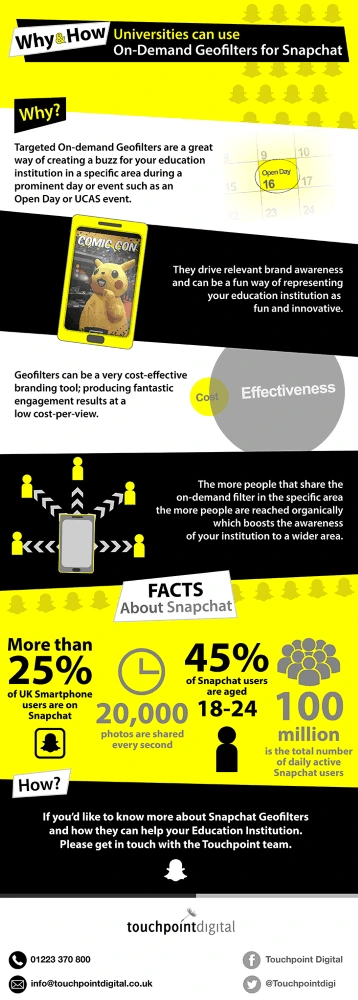
Source: Touchpoint Digital
In practice:
Beyond Snapchat, interactive campus tours, maps & brochures can have a big impact.
Contractors working for The University of Washington built a mobile app that allowed users to explore the new $105-million computer science building before it was built.
The Savannah College of Art and Design boldly embraced virtual reality (VR) back in 2015, sending out Google Cardboard headsets that let 30,000 accepted students explore campuses virtually.
It moved on to augmented reality (AR) next, adding interactive features to a course catalog. The institution has seen a 26% increase in admissions applications after introducing VR and AR recruitment tools.
4. Livestreaming
Livestreaming is being broadly touted as the big must-have for marketers in all industries today. No longer a novelty, it’s changed the face of marketing and the way brands and consumers interact.
When you take a look at the numbers, it’s not hard to see why.
According to Dartmouth, 86% of colleges and universities have a presence on YouTube. That makes sense when you consider that 71% of teens’ typical entertainment consumption is streaming, and one-third is viewed on apps from a mobile device.
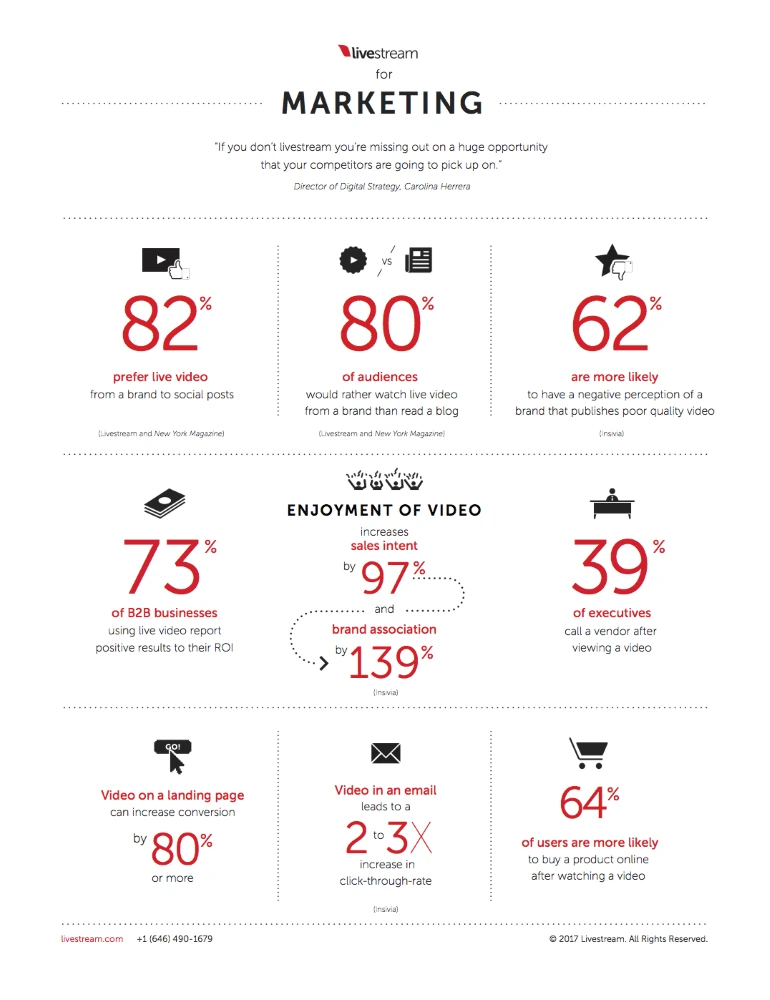
Source: Livestream.com
In practice:
The most common and beneficial use of livestreaming is to broadcast events.
Education institutions can set up livestreams—broadcast either by themselves or by an influencer—to showcase events held throughout the year.
Real-world example
In terms of real-life examples, Western Colorado University struggled to manage their marketing properly for quite some time. It wasn’t until they implemented brand templating software that they were able to keep their brand consistent and save their creative team loads of marketing time.
Sometimes reading the stories of other universities can help shed more light on your own situation. Read Western Colorado’s full case study and see if your creative team has had any of the same struggles.
Key takeaways
In summary, you’ll need to incorporate the following tactics into your digital marketing strategy if you want to hit your enrollment goals:
- Think mobile-first
- Choose the right platforms
- Build a consistent brand
- Answer key questions
To push forward with creative and innovative marketing, the following trends are key:
- Micro-influencers
- User-generated content
- Augmented reality
- Livestreaming
What’s the next big move you’ll make to drive an increase in awareness, enrollment numbers and engagement?
How can higher ed marketing teams build a strong, consistent brand across campus? This downloadable guide will show you how to templatize design at your school.
Not too long ago, universities didn’t have much need for a strong brand. But as the market for funding, recognition, academic talent and even student recruitment has started to heat up, the need has become critical.
A survey by Inside Higher Ed and Gallup showed that in 2017, only 34% of schools polled had met their enrollment targets for the fall term on May 1, which marked a decline from 37% in 2016 and 42% in 2015. With recent setbacks like Covid-19 affecting enrollment, more universities have begun to focus on branding. At the moment, 85% of university leaders are concerned with accelerated rates of student attrition in the short term and 88% are concerned about a decline in overall future student enrollment due to Covid-19.
A strong brand and message can easily convert to higher enrollment, but with the current approach to education branding, it’s easy to see where many universities fall short. To build a stronger brand and improve student retention, follow these steps to develop a stronger brand and message.
How to develop stronger university branding and messaging
1. Collect brand perception data from every group
Universities have a lot of different stakeholders from every corner of campus. If you focus on only one group, it’s easy to miss out on some great university marketing opportunities. In order to solidify your brand and make it accessible to the majority, you need to collect brand perception data from every facet of your campus.
Most universities can be broken down into the following groups:
- Current and prospective students (and their parents)
- Alumni
- Faculty (current and retired)
- Administrative staff
- Corporate partners
- Research funding sources
- Community members and leaders
- Local media, nonprofits and businesses
- University vendors
2. Identify student personas
Once you’ve collected perception data surrounding your university’s brand, you can begin identifying student personas. Developing these personas is a key part of your university branding strategy because it will prevent you from generalizing your brand decisions.
Your established personas will help you recognize the specific attitudes, concerns and criteria that drive prospective students toward you or your competitors.
Follow these steps to build the right personas:
- Divide your student population into groupsE.g., divide returning adult students from recent high school grads.
- Identify similarities for each groupFocus on what their motivations, goals and concerns are.
- Confirm your assumptionsStart surveying your groups to get insight into their wants and needs. For example, you may learn that returning adult students are interested in social connections just like recent high school grands.
By building these personas, it can give you insight into current trends other competitors may be using for recruitment.
3. Identify unique traits
Once you’ve created your student personas, you can start to identify unique traits among them. Begin by considering student niches, your location and your history.
- Student niches: If your university caters to a specific student niche, this can become a strong focal point for your brand identity. For example, a disproportionately high number of part-time students, mature students or international students can potentially attract students in a similar situation.
- Location: Along with student niches, your location is another big part of your university’s appeal. You don’t need to put a huge focus on this, but it can help promote a general atmosphere for your university’s brand.
- History: For most universities, history is an important part of their identities. Even if your university is on the younger side, it can still play a vital role in your brand identity.
How to maintain your university branding
Follow these steps to maintain your university’s brand:
1. Keep brand assets in one place
A critical part of university branding is consistency. If your staff or faculty can’t access your brand assets easily, you run the risk of having marketing items developed that don’t follow your brand. This in turn can undermine all the research and work you’ve put into building a brand that drives enrollment. To avoid this, keep your brand assets in one place.
2. Use lockable templates
Lockable templates will also help keep things consistent across campus. By providing lockable templates, you can put a stop to any rogue designers and ensure that everyone is using your brand assets correctly. Lockable templates don’t have to be rigid — you can provide templates that different departments can personalize.
3. Share templates with faculty and staff
Finally, be sure to share your templates with all faculty and staff. With lockable, easy-to-use templates, anyone can quickly create posters, brochures, flyers and more that can be used throughout your university.
A university’s brand is key to driving enrollment. Your brand is what draws in students, and during a time where enrollment is dropping, it’s more important than ever that your university’s brand is solid and enticing. To get better insight into attracting the modern student, check out our free ebook that will teach you how to evaluate your brand and also offers tips for delivering a consistent recruitment experience.
If you’re in higher education, you’ve probably noticed things are getting tough out there for community colleges, public universities and private institutions alike. A recent decline in college enrollment has some experts concerned, but the reasoning behind the choices students are making about their enrollment in colleges is increasingly complicated.
While it’s tempting to blame the college enrollment decline on the faltering economy or the difficulties of the pandemic, over the past decade, enrollment in higher education has actually fallen by 11% nationwide. It’s clear something more pervasive has been driving the enrollment crisis for some time now. In 2020, the National Student Clearinghouse Research Center reported the percentage of students enrolled continued to trend down 4% for the fall semester.
Let’s take a closer look at some of the potential reasons behind the college enrollment decline and how to address these problems by building a better university brand.
5 factors behind the college enrollment decline
There doesn’t seem to be just one reason behind declining college enrollment numbers. However, taking a closer look at the combination of contributing factors, including falling national student graduation rates and college student retention rates, can help schools tackle challenges in recruiting and retaining students.
1. The recession reset could be responsible for some of the college enrollment decline
In short, what goes up must come down. A stronger economy typically boosts college enrollment. However, in 2011, the reverse happened as an unprecedented number of students pursued higher education when the economy was still emerging from a downturn. The current declining college enrollment rates may be, in part, simply a return to levels of normal recruitment and retention.
2. College enrollment is down in part because there are fewer students
At some point, simple math prevails. Fewer births mean fewer students, and fewer students mean fewer college students. Shifting demographics and dropping birth rates from twenty years ago means a smaller pool of high school graduates for colleges to recruit from. This forecast of dwindling student populations is complicated by the fact that fewer high school graduates are choosing to go to college.
3. The growing cost of tuition is a barrier to college enrollment
As you may have guessed, sharply rising tuition rates and less investment by states in higher education pushes more of the cost of college onto parents and students. In fact, rising tuition rates are outpacing inflation by a large margin. This creates barriers to pursuing college enrollment, especially among first-time college students and adults who already have significant financial commitments.
4. Students worry college degrees don’t hold value anymore
The burden of student loans has become a hotly debated topic nationally, and it’s fueled concern about whether college degrees still hold value in the modern economy. Public and community colleges seem to present a better return on investment up front, but research indicates private colleges still provide better long-term gains for those who can afford them.
5. The pandemic definitely isn’t helping the college enrollment decline
While the coronavirus crisis isn’t the sole cause of the current college enrollment decline, it’s certainly not helping. Colleges and universities reported up to 25% of potential students postponed college enrollment because of coronavirus. Many of these students cited difficult financial choices as a result of their family’s economic challenges. This is compounded by an already high college dropout rate that is currently hovering around 40%.
How to increase college enrollment at your school
Leveraging the following marketing tactics isn’t a silver bullet, but it can help your school overcome obstacles to recruitment, strengthen your college brand, and drive better student enrollment and retention numbers.
Know your audience
It’s possible your potential students aren’t who you think they are. While high school graduates are the most likely to enroll in college, increasingly diverse populations now crowd the halls and virtual classrooms at today’s colleges and universities.
Focus your college recruitment and create marketing personas shaped by non-traditional potential student populations. It may help you reach a broader audience, including adults going back to school, first-generation college students and international students.
Focus on your brand
Just as successful companies build brands that are easily recognizable to consumers, colleges and universities should invest in branding that means something to students. Brand building isn’t just about having a cool logo or a best-in-class website. It’s really about crafting a niche and making sure your branding reflects those institutional strengths. Whether it’s fantastic study abroad experiences or a thriving esports community, find what your school does well and incorporate it into how you market to potential students.
Get creative
College fairs and mail brochures aren’t going to cut it anymore. To boost enrollment, consider focusing on new marketing channels in social media such as YouTube or recruiting brand ambassadors on Instagram.
You need to reach potential students where they live, and increasingly that’s online. Take stock of your internet presence and consider how you can elevate your school profiles and expand your audience. Consider who your target demographic is and how best to communicate with those students given how they spend their day and what they care about.
Be consistent
It’s far easier and more cost-effective to keep the students you have than to recruit new ones. It’s also true that supporting your existing students and helping them thrive on campus can create the kind of alumni that’ll be brand ambassadors for life. Former students can go on to be vocal alumni who provide the kind of buzz for your college brand that money can’t buy.
Part of creating a dynamic brand is to get consistent with your university branding and create content your existing students will be proud to promote and share. Brand templating can help your team keep assets in one place, reduce the risk of off-brand content, and allow anyone to create and use branded content when and where they need it.
While the world faces unprecedented challenges and rapidly evolving technology, the future of higher education, in particular, appears to be headed for a precipice. The culmination of widespread online learning, significant enrollment decline, and increasing concerns about student loan debt have disrupted traditional models of learning and raised important questions about the future of education.
In the midst of this chaotic sea change, educators see an opportunity for colleges and universities to better evolve to embrace the needs of students, communities, and society at large. Understanding the changing landscape of education can help these institutions adapt and position themselves for a successful transition into the future of education.
What does the future of higher education look like?
Seismic shifts in the way learning is delivered have the potential to reshape the education industry. In the wake of the COVID-19 pandemic, a Barnes & Noble Education study indicated 70% of college students surveyed said they wanted “less rigid” learning experiences.
“The pandemic did not change the path for higher education, but it did change the speed at which we’re traveling on that path. Within the next 10 years, we will see a transformation of the student experience — from admissions through graduation — that will ultimately create a better, more inclusive and smarter world.”
Michael Huseby, CEO and Chairman of Barnes & Noble Education
Let’s take a closer look at what the future of higher education holds and what it will mean both for the student experience, the educators who support them, and the institutions that deliver learning.
College enrollment decline means changing student demographics
The education industry has been sounding the alarm about enrollment decline for a few years now, but disruption of attendance due to the pandemic has both amplified and accelerated the problem. After hitting a peak in 2011, college enrollment has been steadily falling for the past decade. In private colleges like Harvard, 20% of college students chose to defer enrollment last year due to the pandemic and unanticipated economic challenges.
Some enrollment decline is inevitable due to shifting demographics and a smaller pool of high school graduates. But this is a numbers problem that challenges colleges and universities to think outside the box and recruit nontraditional students. Adult learners, international students and other underserved populations could fill the future halls of higher education. However, educational institutions need to make significant changes to how they recruit and support students. And colleges and universities will have to retool how they deliver and fund learning to convince underserved and first-generation students to invest in a degree.
The role of technology and online learning in the future of education
Remote learning is here to stay, but conversations surrounding the role of technology in the future of higher education can become contentious. While most colleges and universities have some sort of online program, there is widespread debate about whether distance learning provides the same educational value as brick-and-mortar classes.
While most institutions will continue to embrace all things internet, the clamor and cry for better digital student experiences is clear. In the College 2030 Report from Barnes & Noble, 82% of faculty felt they understood how students learn, but less than half of students surveyed agreed with that statement. There is also a disconnect regarding the value of online learning, with 94% of students saying it should cost less than in-person classes, while 43% of faculty disagreed.
The future of higher education will be more affordable and accessible
Ongoing concern about the burden of student loan debt and the value of a college degree has pushed the issue of affordability and access to higher education front and center. Students and families are demanding college experiences provide a better value, but there are lots of questions about how to deliver on that expectation.
Nevertheless, college degrees are increasingly considered a necessary part of successful careers, and more employers are demanding them for entry-level jobs. This phenomenon, referred to as “degree inflation,” is likely to accelerate in the coming years as increasing automation means less manual labor and more positions requiring higher-level technology or communication skills.
What changing expectations mean for the future of education
It’s clear that expectations around what the student experience should look like are driving change in higher education. While forecasting the direction these forces will push colleges and universities is tricky, it’s worthwhile to consider how these trends might shape the future college experience.
Hybrid models of education will become the norm
For many decades, the formula for a college experience was a familiar one. Four-year residential colleges were the norm and catered to a young student population fresh out of high school. Part-time and adult students were the domain of community colleges and other low-cost public universities.
The college experience of the future won’t fit this paradigm, and that’s a good thing. A diversifying college student population means higher education will invest in blended models of learning that offer the best of both worlds. Hybrid educational experiences with both in-person and online options better meet the needs of the underserved students and ultimately offer everyone better access and value.
Expect a focus on return on investment (ROI)
Return on investment isn’t just a business buzzword anymore. Students and families are viewing the decision to attend college as an investment, and they want educational institutions to be transparent about affordability, student loan debt and future job prospects.
In short, when shopping for a college, students are increasingly savvy about ROI. As consumers of higher education, they are demanding more value from their college experience. Education institutions will find ways to build more bang for the buck into degree programs with options like corporate partnerships, subsidized internships, study abroad opportunities, and career and job placement assistance or networking communities for alumni.
A culture of accountability is on the horizon for colleges and universities
The consensus among employers is clear. A growing number of colleges and universities don’t confer degrees that translate into meaningful career or employability skills. On-the-job training in areas like communication and leadership often fills some gaps, but this skills divide is a source of growing frustration for both employers and employees.
Expect a culture of accountability to grow not only around the knowledge colleges deliver but also around the role they play in producing more competent, confident and well-rounded graduates. To deliver on this promise, higher education will need to find better ways to connect students with real-world opportunities for growth and advancement.
College degrees will increasingly deliver more than career skills
Whether virtual, commuter or residential, college campuses provide much more than housing and healthcare for students. They provide community and connection. Grappling with the impacts of societal issues such as racial equality and economic disenfranchisement is increasingly the domain of educational institutions.
In the future, colleges and universities will look beyond career readiness into the ways in which they encourage digital citizenship, foster emotional intelligence, and build community leadership.
The role of university branding in the future of education
University branding can play a role not only in addressing today’s college enrollment decline but also in preparing institutions to meet the future of higher education head-on. But building a stronger brand is about more than a recognizable logo. It’s about producing consistent, high-quality content across all your marketing channels.
Here are a few tips to help your school transform its higher education marketing and embrace a bigger, brighter and more inclusive future for both students and educators.
- Think about tone
Take a close look at your messaging on social media, blogs, brochures and emails. What do the visual aspects of that content say about your college? Think not just about what you’re saying but how you’re saying it. If the messaging isn’t consistent, it may be time to invest in a brand templating platform like Lucidpress.
- Put it all in one place
Consistent, high-quality branded assets are fantastic tools as long as your marketing teams know where to find them. Centralize your resources and make sure everyone who engages with prospective students and all your stakeholders have access to up-to-date marketing materials.
- Optimize campaigns
Launching successful marketing campaigns requires planning to ensure consistent messaging across all your channels. You should also evaluate past campaigns to glean insights about how to improve and hone your content to encourage engagement. Think carefully about your audience and how to reach them where they spend most of their time.
The future of higher education may seem like uncharted territory at the moment, but it’s an exciting time full of possibilities for students, educators and administrators alike. Embracing technology and finding ways to expand access and affordability to education will help guide institutions through these challenging times and help create opportunities for us all.
College orientation is an opportunity for incoming students to get their first glimpse of campus life. But it can also be overwhelming for a freshman who has never been away from home. The best college orientation programs welcome new students with fun orientation activities that encourage student engagement and connection.
Let’s explore college orientation ideas and icebreakers for college students that create a welcoming environment and ultimately help student retention rates in the first year and beyond.
Tips for college orientation ideas
Here are some tips to keep in mind when brainstorming student orientation ideas.
Keep it interactive
Whether your college orientation program is in person or online, find ways to help students connect. Carve out some time for new students to be social and share more about themselves.
Practice makes perfect
You’ve designed the best college orientation program, but do a practice run to work out any hiccups. Expect the unexpected such as technological complications and plan ahead.
Think about access
There are many barriers that prevent new students from attending college orientation, including a lack of financial resources. Whether your program is in-person or online, ensure those in need can participate.
Make it social
The gold standard of higher ed marketing is to reach students where they are. Most of the time, that’s on Instagram, TikTok or YouTube. The best college orientation programs create social media campaigns to accompany college orientation activities.
Swag is your friend
Everyone’s favorite word is free, so send swag to new students. Think beyond T-shirts and go for practical prizes like bookstore gift cards. Be sure to broadcast freebies on your higher ed social media accounts to incentivize participation.
5 in-person college orientation ideas
If you’re hosting incoming students face to face, here are college orientation ideas to encourage student engagement.
1. Photo scavenger hunt
This orientation activity doubles as a campus tour. Create clues for a dozen must-visit places on campus, then break out into small groups. Challenge teams to take a selfie at each place and tag themselves on social media.
2. Beach ball icebreakers for college students
If you’ve got a beach ball, you’ve got the makings for a college-style icebreaker. Here are mini-activities to ease awkwardness.
- Group juggle: Have the freshman with the ball say their name, then pass to someone new who says the names they’ve already heard and adds their own.
- Warp speed: As the beach ball gets tossed, each person who catches it says their name. Every minute or so, beach balls are added until this becomes a flurry of introductions.
- Pick a question: Use a sharpie to cover the beach ball with questions, then have the person who catches answer the one closest to their left or right hand.
3. Insider guide to campus life
Give incoming students the inside track to campus life from existing students. In addition to a student panel during orientation, create a pdf with upperclassmen tips and tricks like the best study spots, favorite food trucks and book-buying hacks.
4. School spirit games
Joining a community means becoming part of something larger than yourself. Stoke school spirit by sharing a video of favorite campus moments. Then have incoming students play school-spirit Jeopardy to test their knowledge of campus traditions.
5. Marshmallow challenge
The best college orientation programs take time to break it down. Give your incoming students one-on-one time by passing out marshmallows and toothpicks and challenging small groups to come up with a creative structure. Then step back and watch the magic happen.
5 virtual college orientation ideas and online icebreakers
With a little effort, these college orientation ideas can connect students virtually and foster community both online and on campus.
1. Google Map it
One way to help new students connect is to collaborate on a Google map. Instruct incoming freshmen to drop a pin on their hometown, noting any fun or fascinating facts about where they are from.
2. Unboxing videos
If you’re going to send some swag, you can use welcome packages to encourage engagement on social media. Ask students to upload videos of unboxing their swag or do it live on camera during virtual orientation.
3. Meet your match
Think of this student orientation idea as virtual speed dating for friends. Pair new students up as orientation buddies. You can do this by creating a Slack channel for direct messaging or using the meeting room chat to exchange contact info.
4. Online campus tour
Navigating campus is much easier in person, but you can make up ground with some online creativity. Drone footage, scavenger hunts of the campus website, and student-led video tour reels are ways to get a taste for the campus at a distance.
5. Break the ice online
It seems tricky to get folks talking to webcams, but many in-person icebreakers for college students can be adapted for virtual events. Here are a few to kick off your online college orientation activities.
- Then vs. now: Ask students to share two pics that represent what they wanted to be when they were little versus what they want to be now. They can use Instagram story filters to make a collage and tag your college to win prizes.
- Stranded: This is a classic question that always makes for interesting introductions. Ask students to identify the one item they would take if stranded on a deserted island.
- Two truths, one lie: Most students are familiar with this icebreaker, which involves making three statements (one of which is a lie). The trick is spotting the falsehood and crafting a believable deception.
- Grab & tell: Have students in the virtual event grab one thing within arm’s reach and explain what it is and why they chose it.
- Give me some background: Pepper your virtual orientation with personality by inviting students to upload a customized background. If your meeting room has fun filters, show students how to use them.
Once upon a time, conversations about education revolved around the needs of millennials, but Generation Z college students have arrived and with them the potential to reshape the four-year experience. Gen Z learners are those born after 1996, and they are the cohort currently graduating from high school and facing decisions about investing in a college experience.
Like previous generations, Gen Z students have specific needs and learning preferences shaped by evolving societal expectations and technology advancements. We’ll take a closer look at the characteristics of Generation Z students and how those factors influence not just today’s four-year degree programs but tomorrow’s college marketing and recruitment strategies.
How Generation Z college students are different
Perceptions of each generation are too often shaped by cliches, and Generation Z students are no different. The suggestion that Generation Z is addicted to their smartphones, reliant on social media, and dependent on their parents will sound eerily familiar to millennials. While age groups aren’t monoliths, certain demographics and trends can get beyond cliches to tell us about the unique challenges Generation Z students face.
Generation Z college cohorts are more diverse than their predecessors
Nearly half of post-millennial students are racial or ethnic minorities, and by 2026, it’s expected the next generation will be a majority of non-white students. Currently, one out of every four Gen Z students are Hispanic, followed by 14% who are Black and 6% who are Asian. Today’s college students are also more likely to hail from urban areas and be more well-educated than their predecessors.
Like millennials, Generation Z college students live with their parents
During the pandemic, it was widely reported that a majority of young adults were living with their parents. In truth, this is a trend that presented itself before coronavirus and has stayed consistent from millennials through Generation Z. Today’s college-age students are more likely to live with their parents and for longer stretches than previous generations.
Generation Z students grew up entirely in the age of the internet
The internet has shaped our lives in profound ways, but perhaps none have felt the effects as much as Generation Z. They were born as the world wide web and smartphones were truly becoming ubiquitous and have lived their entire lives with modern technology. Social media specifically is the cornerstone of how they communicate and forge relationships.
Generation Z students are more likely to report mental health concerns
A 2018 report from the American Psychology Association raised the alarm that only 45% of Generation Z students reported themselves to be in good or excellent mental health compared with 56% of millenials. Primary stressors for Generation Z included mass shootings, suicide rates and climate change. It’s certain the health concerns and economic challenges of the pandemic have only added to this Pandora’s box of worries.
Generation Z students have specific learning preferences
The characteristics that define Generation Z college students have driven a set of specific learning preferences. Understanding how these students prefer to learn and what environments they thrive in can help inform both college recruitment strategy and a better college experience.
Generation Z college students are pragmatic
As tuition costs rise, both students and their parents are worried that degrees don’t hold the same value they did for previous generations. In the face of mounting student loan debt, Generation Z college students want to make sure their college pays off as an investment by focusing on the acquisition of practical, career-focused learning.
Modern college students expect flexible learning models
You’d assume that the newest generation of college students who cut their teeth on YouTube would lean into virtual education. However, surveys indicate Generation Z college students are skeptical that remote learning can provide what they need to succeed in the workplace. Increasingly, Gen Z students prefer hybrid models that combine world-class online learning environments with in-person engagement.
Generation Z wants to move at their own pace
While the latest generation of college students is quite comfortable with virtual learning, they prefer opportunities for independent work, project-based learning and a self-paced curriculum. Accustomed to having a wealth of knowledge at their fingertips, Generation Z college students are more focused on acquiring the soft skills that employers view as increasingly essential.
How to adapt education for Generation Z college students
Attracting Generation Z college students isn’t just about updating your university branding and getting visibility on social media channels. It’s also about carefully considering the challenges Generation Z college students face and how you can support them with a better four-year degree experience.
Get serious about community and inclusion
The diversity of Generation Z demands that educational institutions invest extra effort in creating an inclusive and welcoming environment. If you want today’s college students to call your campus home, communicate support and devote resources to establishing safe communities for racial and ethnic minorities as well as LGBTQ populations. Generation Z is full of seasoned activists who believe there are no shortcuts to being a trusted ally, so be prepared to do the work.
Build more value into degree programs
Selling Generation Z college students on the burden of student loans means providing more bang for the buck in a four-year experience. Think expanding internship opportunities, career placement services, and classes that provide plenty of hands-on learning experience. A network of engaged alumni can also help students get their foot in the door of that dream job.
Diversify the learning model
The pandemic drove many education institutions to expand remote learning. Now that the virtual infrastructure exists, colleges should use it to develop better hybrid-learning models that blend remote, in-person and experimental classes into a flexible learning model Generation Z students will appreciate.
Support services are crucial
Generation Z students need more support services than many campuses provide. College budgets should invest in expanding mental health services and offering holistic wellness programs that benefit students both in-person and at a distance. Considering how to better support mental health and wellness in high-stress degree programs is also a must.
Graduate to better, more immersive technology
Speaking of budgets, limping along on last year’s tech isn’t going to cut it with Generation Z. Start investing in virtual reality, esports communities, and learning spaces designed to accommodate immersive experiences. Generation Z college students are mobile. Make sure your technology can keep up.
Give Gen Z’s parents more opportunities for involvement
Generation Z increasingly lives at home with their parents, so leverage those relationships to form a system of support for students and create a healthier college community. While it may pose some challenges for colleges up-front, studies show the long-term payoff on parental involvement is more stability and a better chance of success for students.
Providing an exceptional four-year experience to Generation Z college students will force educational institutions to navigate a different roadmap than the one used for millennials. But setting aside cliches and approaching the challenges students face with compassion is well worth the effort to recruit the most well-educated and diverse generation of college students in history.
Which Sweet 16 team has the most well-known brand?
That’s the question we’ve set out to answer.
As branding fanatics, we wanted to take the NCAA’s Sweet 16 teams and put them into our own branding bracket to see how well people recognize these brands and why. We surveyed nearly 1,000 participants’ ability to identify brands according to font and color. We also asked them to rank the 16 college brands by overall preference.
The results were pretty interesting:
- UCLA was ranked as the brand people prefer most
- UCLA also took the top spot when it comes to brand color (90% of respondents correctly identified its color)
- Villanova took the top spot when it comes to font (73% of respondents correctly identified its font)
The Final Four Color Bracket
Most people could identify these top four schools’ colors:
- UCLA (90%)
- Kansas (89%)
- Michigan (88%)
- Arkansas (87%)
The Final Four Font Bracket
Most people could identify these top four schools’ font:
- Villanova (73%)
- Iowa State (71%)
- University of Arizona (71%)
- Kansas (62%)
The Final Four Favorite Brand Bracket
Most preferred school brands of the NCAA 2022 Sweet 16:
- UCLA
- Michigan
- Duke
- UNC
Our survey results show that the majority of people are better at identifying a school’s colors correctly than its font: Not a single school had higher font recognition than color.
UCLA ranks as the number one brand people prefer (92.8%), but if we break it down by respondents, Gen Zers have Texan pride, ranking Houston and Texas Tech as the number 1 and 3 spots in regard to brand preference.
What’s more, Gen Z cares more about a school’s branding when choosing a school to apply for than any previous generation. (Gen Z ranked its importance as 4/10, while other generations ranked it 3.4/10.)
Keep reading for more of our key findings…
More March Madness brand stats:
- Overall, respondents were much better at recognizing a school by its colors than by its font. For instance…
- 89% of people correctly identified University of Kansas’ colors, but only 62% correctly identified its font.
- 88% of respondents correctly identified University of Michigan’s colors, but only 52% correctly identified its font.
- 90% of respondents correctly identified UCLA’s colors, but only 71% correctly identified its font.
- 87% of respondents correctly identified University of Arkansas’ colors, but only 43% correctly identified its font.
- UCLA ranks as the number one brand people prefer (92.8%), but if we break it down by respondents, Gen Zers have Texan pride, ranking Houston and Texas Tech as the number 1 and 3 spots in regards to brand preference.
- Carolina schools are strong contenders for brand recognition as well: Duke and UNC hold seats in the final four “favorite” bracket and scored highly in the color surveys as well, each with above 80% accuracy.
- Gen Z students care more about their university’s branding when choosing a school than other generations.
- When asked what played into their decision for ranking their preferred brand, people said overall brand recognition — or how well-known a school is — was the most important factor:
- 47% brand recognition
- 21% overall appearance
- 16% color
- 10% mascot
- 5% font
- However, it seems that color must play a large role in determining brand recognition and preference, as UCLA and Michigan hold seats in both the Final Four color and favorite brackets.
- The majority of students/alumni think their alma mater is doing a great job with the look of their brand, but they take even more pride in seeing their school logo
- On a scale from 1-10, people give their schools an average 5/10 in overall branding, but ranked the amount of school pride they feel upon seeing their logo as 5.3/10